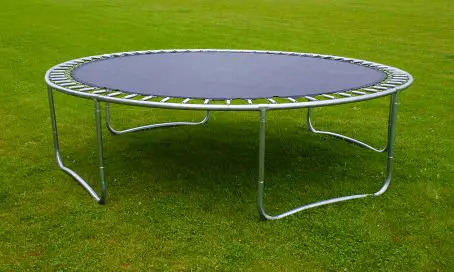Playing on a trampoline can be exciting and enjoyable. As a result, it is best to set it up in a secure location of your property. When erecting the trampoline, you must consider how to anchor it to prevent it from being blown away. Aside from locating it in a safe, wind-protected location, you must also verify that your trampoline is properly secured to the ground.
So, what’s the best way to anchor down a trampoline? There are two ways to anchor down trampolines. One method is to utilize trampoline anchors, which are long, twisting rods that may be buried in the ground, while the other is to use wind stakes.
Before putting the trampoline over the wind pegs, they are buried in the ground with cement binding. This is typically regarded as a long-term solution to flying trampolines. Trampoline anchors are particularly beneficial because the majority of them are made of spiral steel, which supports the trampoline considerably better.
Anchor Down A Trampoline Using Wind Anchor Kit
Trampolines now come with safety netting as standard equipment. All of these factors add to a significant risk of damage during severe winds. The trampoline goes airborne, preventing the wind from escaping. To anchor your trampoline using a simple trampoline wind anchor kit, follow the easy steps detailed below.
- Measure and Mark
From the inside of each of two legs, take a measurement that extends about 35 cm towards the outside of each leg. Mark where it is, just in time to take the first step in the staircase.
- Install the Picket
Hit the picketing stick with a hammered head, about 60 degree from the top edge. Keep hitting it, hitting it firmly into the ground, turning it around so that it does not touch the ground. Now that the picket is solidly embedded in the ground, put on the cap.
- Hook and Loop
Wrap the straps around the ring on your trampoline’s top frame, where the springs are attached. Make sure the strap’s “A” end is placed into the strap’s “B” end.
- Install the Ratchett
Thread the ratchet’s “hook” end through the star picket and the other end you just wrapped around the trampoline frame. Insert the ratchet’s “A” end through the other ratchet.
- Tighten and Repeat
Just keep tightening the ratcheting mechanism for as long as the strap is securely fastened. Be very cautious about over-tightening the ratchets. Do this three more times until the straps are tightly fastened, then remove the elastic bands. Once that is accomplished, it is time to install the straps in place.

Anchor Down A Trampoline Using Wind Stakes
Even though wind stakes are not as secure as ground stakes, no one can say that is more secure than nothing. Installing a set of temporary poles using a single person’s power is as easy as installing a single person to set up a set of stakes.
Keep in mind that some trampolines are not safe to secure with a wind stake. You need to use another type if it doesn’t fit. Trampolines, which are fastened to their legs by simply locking the legs into place by gravity, are best positioned to secure the frame, not the legs.
- Pick Up A Set of U-Shaped Wind Stakes
Similar to wind stakes, wind stakes are designed to curve tightly into a U-shape to force wind through narrow spaces. These are steel wind stakes that are bent like a U shape. These wind stakes are usually sold in sets of four.
- Position Each Wind Stake
Place the stakes so that when the trampoline is bouncing, the leg that supports the stakes is at an equal distance from the ground. Wind stake feet are best secured by placing them equally spaced apart to protect the legs. In general, the stake distances are only two inches, which is still sufficient to fit most trampoline legs.
- Tap The Stakes Into The Ground
It will only require a couple of taps to put the stakes in the ground. Once the stakes are driven into the ground, start to jig them a bit to see how stable the ground is underneath them. If the stakes are too high, pull the stakes up by one of the ends so that the points are level. Otherwise, push the stakes back down to level the ground.
If the ground is too hard to sink the wind stakes, lightly spray it with water first to soften it up. Consider using at least two sets of wind stakes if you reside in an area prone to high winds and storms.
If it is necessary to put down some wind stake or other fixed pieces to hold the trampoline down, make sure that the top portion of the disk is secured to the ground properly. When there is high wind or a very bad storm, the top of the trampoline can be blown off of the legs of the trampoline. It is important to purchase droppers, star pickets, or caps to help hold the top of the trampoline. Typically, cargo trucks are secured by ratcheting straps that attach to the back of a truck.
Carefully driving the pickets or drops in the ground will allow them to fit around the circumference of the dummy that is being used. Go to step two, just attach the ratcheting straps to the frame of the trampoline. Then secure the trampoline to the ground using a star or picket anchor.
Whether you live in a high-wind area or not, proper trampoline anchoring is vital. The consequences of making a mistake can be severe. Trampoline anchors come in a variety of styles, but all of them are highly effective at anchoring your equipment and ensuring its continuing safety even in heavy winds and hurricanes.
Just make sure to obtain real trampoline anchors rather than knock-offs. By securing your trampoline, you reduce the likelihood of losing your investment due to adverse weather.

